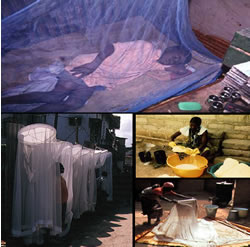Insecticide-Treated Bed Nets

Insecticide-treated bed nets (ITNs) are now a major intervention for malaria control.
Insecticide-treated bed nets (ITNs) are a form of personal protection that has been shown to reduce malaria illness, severe disease and death due to malaria in endemic regions. In community-wide trials in several African settings, ITNs have been shown to reduce the death of children under 5 years from all causes by about 20%.
How Do ITNs Work?
Bed nets that are not treated form a protective barrier around people sleeping under them. However, mosquitoes can feed on people through the nets, and nets with even a few small holes provide little, if any, protection. Applying an insecticide greatly improves the protection of bed nets. The insecticides used for treating bed nets kill mosquitoes, as well as other insects. The insecticides also repel mosquitoes, reducing the number that enter the house and attempt to feed on people inside. In addition, if high community coverage is achieved, the numbers of mosquitoes, as well as their length of life will be reduced. When this happens, all members of the community are protected, regardless of whether or not they are using a bed net. To achieve such effects, high community coverage is required. High community coverage is also required for another prevention method, indoor residual spraying.
Net Materials and Insecticides
There are several types of nets available. Nets may vary by size, material, and/or treatment. Most nets are made of polyester but nets are also available in cotton, polyethylene, or polypropylene.
Only pyrethroid insecticides are approved for use on ITNs. These insecticides have been to shown to pose very low health risks to humans and other mammals, but are highly toxic to insects and knock them down, even at very low doses. Pyrethroids do not rapidly break down unless washed or exposed to sunlight.
Previously, nets had to be retreated every 6-12 months, more frequently if the nets were washed. Nets were retreated by simply dipping them in a mixture of water and insecticide and allowing them to dry in a shady place. The need for frequent retreatment was a major barrier to widespread use of ITNs in endemic countries. The additional cost of the insecticide and the lack of understanding of its importance resulted in very low retreatment rates in most African countries.
Long-Lasting Insecticide-treated Nets (LLINs)
More recently, several companies have developed long-lasting insecticide-treated nets (LLINs) that maintain effective levels of insecticide for at least 3 years. The WHO Pesticide Evaluation Scheme (WHOPES) has given either full or interm approval to 12 of these LLINs for use in the prevention of malaria. CDC is currently testing some of these and other LLINs in Atlanta and Kenya to assess their performance and durability in the field.
LLINs have been associated with sharp decreases in malaria in countries where malaria programs have achieved high LLIN coverage. WHO now recommends that LLINs be distributed to and used by all people ("universal coverage") in malarious areas, not just the most vulnerable groups: pregnant women and young children. A recent gap analysis estimated that between 2008 and 2012, 327 million LLINs would be needed to achieve full coverage of women and children in malaria-endemic countries of Africa, while 545 million LLINs would be needed to achieve universal coverage in that same region.
Mobilizing resources to procure these nets remains a major challenge. After much debate, WHO now recommends that LLINs be provided free. Multilateral and bilateral donors and programs such as the Global Fund Against HIV/AIDs, Tuberculosis, and Malaria and the President’s Malaria Initiative support the purchase of LLINs for many countries. Individual donations of nets can be made through organizations such as Malaria No More or Nothing But Nets.
Travelers to malaria-risk areas may also use ITNs as one of several precautions against malaria.
Get email updates about Malaria
To receive email updates about this page, enter your email address:
Contact Us:
- Centers for Disease Control and Prevention
1600 Clifton Rd
MS A-06
Atlanta, GA 30333 - Health care providers needing assistance with diagnosis or management of suspected cases of malaria should call the CDC Malaria Hotline:
770-488-7788 or 855-856-4713 toll-free
(M-F, 9am-5pm, eastern time). - Emergency consultation after hours, call:
770-488-7100
and request to speak with a CDC Malaria Branch clinician. - malaria@cdc.gov


